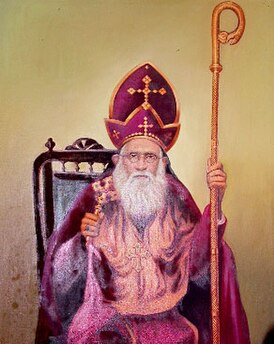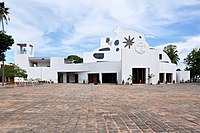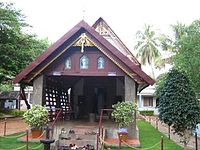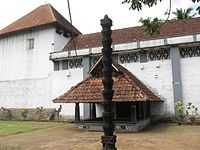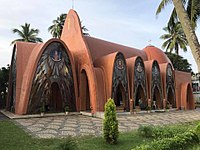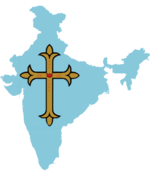Malankara Orthodox Syrian Church
Thank you for being part of the Bharatpedia family! 0% transparency: ₹0 raised out of ₹100,000 (0 supporter) |
This article needs additional citations for verification. (June 2019) |
| File:Catholicate Emblem of MOSC.png Malankara Orthodox Syrian Church | |
|---|---|
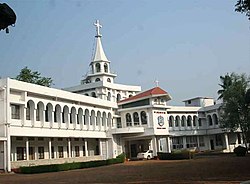 Catholicate Palace in Kottayam, India | |
| Classification | Oriental Orthodox |
| Orientation | Eastern Christianity |
| Scripture | Peshitta Non-Nestorian Eastern Syriac |
| Theology | Miaphysitism |
| Polity | Episcopal |
| Governance | Episcopal Synod |
| Moderator | Moran Mar Baseliose Mar Thoma Paulose Second |
| Region | India and the Nasrani Malayali diaspora |
| Language | Syriac, Suriyani Malayalam, Konkani, Malayalam, English |
| Liturgy | [[Non-Catholic, Non-Antiochian, Pre-Nestorian Eastern Syriac Liturgy of Mar Adaii and Mar Mari upto 1598[1]]], [[Liturgy of St. James of Jerusalem from 1665 till now-Greek St. James Liturgy of Jerusalem and its Eastern Syriac Translation from 1665 to 1871 in the absence of Non-Catholic, Non-Antiochian and Pre-Nestorian Eastern Syriac Liturgy of Mar Adaii and Mar Mari burned by Catholic Missionaries, Syriac Orthodox Church of Antioch's Western Syriac Translation of Greek St. James Liturgy from 1872 due to compulsion from the then Patriarch of Syriac Orthodox Church of Antioch[2]]] |
| Headquarters | Catholicate Palace, Kottayam, Kerala, India [3] |
| Founder | Thomas the Apostle by tradition. |
| Origin | AD52 (1st century by tradition-Apostolic Era)[4] |
| Merger of | Oriental orthodox Communion |
| Separations | 1.Syro Malabar Catholic Church in 1663
2.Church of South India during British Era 3. Malankara Marthoma Syrian Church in 1888 4. Malabar Independent Syrian Church during Antiochian Overrule 5. Syro Malankara Catholic Church in 1930 6. Jacobite Syrian Christian Church in 2002 |
| Members | 1 million (approximately)[5] 494,000 in Kerala (2011 Kerala state census)[6] |
| Other name(s) | Malankara Church (മലങ്കര സഭ), Indian Orthodox Church, Mar Thoma Nazrani Sabha (മാർ തോമ നസ്രാണി സഭ), Tharisaaykkaar (തരിസായ്ക്കാർ), Dhariyaaykkar (ദരിയായ്ക്കാർ) |
| Official website | mosc.in |
Template:Oriental Orthodox sidebar
| Part of a series on |
| Christianity in India |
|---|
 |
The Malankara Orthodox Syrian Church (MOSC)[7] also known as the Indian Orthodox Church,[8] is an autocephalous[9][10] Oriental Orthodox church based in Kerala, India. The church serves India's Saint Thomas Christian (also known as Nasrani) population. According to tradition, the church originated in the missions of Thomas the Apostle in the 1st century.[11]
The autocephalous[12] Catholicos of the East and Malankara Metropolitan (currently Sede vacante), is the primate of the church. It employs the Malankara Rite, an Indian form of the St. James Liturgy. It is a member of the World Council of Churches (WCC). The Malankara Orthodox Syrian Church regained full autocephaly in 1912, and remains in communion with the other five Oriental Orthodox churches, including the Syriac Orthodox Church of Antioch[dubious ] and its own autonomous branch the Jacobite Syrian Christian Church Puthankurish (In 2002 by the supporters of Patriarch of Syriac Orthodox Church of Antioch who initially Signed Affidavit in Supreme Court of India that they accept the validity of Malankara Orthodox Syrian Church Constitution of 1934, they will abide by it & that they will participate in Malankara Association of that year which will be held at Parumala in the Presence of Supreme Court Justice Maleemad According to the Verdict of Supreme Court Bench but on the day of Association boycotted it, went to Puthankurish and formed the Society titled Jacobite Syrian Christian Church, Puthankurish which was Decalred Illegal Null and Void by Supreme Court of India in its Final Verdict of 3rd July, 2017.), the Coptic Orthodox Church of Alexandria, the Armenian Apostolic Church, the Ethiopian Orthodox Tewahedo Church and the Eritrean Orthodox Tewahedo Church. The Malankara Orthodox Syrian Church drafted and formally adopted a constitution in 1934, wherein the church formally declared the Malankara Metropolitan and the Catholicos of the East as one.[13]
The Malankara Orthodox Syrian Church holds to miaphysitism,[14][15] which holds that in the one person of Jesus Christ, divinity and humanity are united in one (μία, mia) nature (φύσις – "physis") without separation, without confusion, without alteration and without mixing[16] where Christ is consubstantial with God the Father. Around 500 bishops within the Patriarchates of Alexandria, Antioch and Jerusalem refused to accept the dyophysitism (two natures) doctrine decreed by the 4th ecumenical council, the Council of Chalcedon in 451,[dubious ] an incident that resulted in the first major split in the main body of the Christian Church. While the Oriental Orthodox churches rejected the Chalcedonian definition, the sees later would become the Catholic Church and the Eastern Orthodox Church accepted this council.[17]
According to the 2011 Census of Kerala it was, with a membership of 493,858, the third largest Christian church in the state, coming after the Syro-Malabar Church (2,346,000) and the Latin Catholic Church (932,733).[18]
History[edit]
Early history[edit]
The Malankara Orthodox Church was founded by Apostle Saint Thomas.[citation needed] Even though the church was independent in administration. It had relationships between Churches of Antioch,Persia and Alexandria.[dubious ][19][citation needed]They received clerical support from Persian bishops, who traveled to Kerala in merchant ships on the spice route. During the 16th century, efforts by the Portuguese Padroado to bring the Saint Thomas Christians into Latin-rite Catholicism led to the first of several rifts in the community. The Saint Thomas Christians are currently divided into several groups.
They were under the leadership of a Jathikku Karthavyan / ജാതിക്ക് കർത്തവ്യൻ who was called by Persians as Arkkadiyaakkon / അർക്കദിയാക്കോൻ (a native ecclesiastical head with temporal powers, deriving from the Greek word'arkhidiākonos')[20]. The Saint Thomas Christians were in communion with the Church of the East, centered in Persia.[21][22] The indigenous Church of Malabar (Malankara) followed the faith and traditions of Thomas the Apostle. Portuguese Jesuits attempted to annex the native Christians to the Latin Church at the 1599 Synod of Diamper. The Saint Thomas Christians, who were opposed to the Portuguese Padroado missionaries, took the Coonan Cross Oath on 3 January 1653.[23][24][25] The Dutch East India Company defeated the Portuguese for control of the Malabar spice trade in 1663. Patriarch Gregorios Abdal Jaleel of Jerusalem witnessed the 1665 ordination of Thomas as Bishop Thoma I, who brought the Greek Liturgy of St. James which later laid the foundation for adopting Western Syriac translation of St. James Liturgy and in 1876 in the absence of the Original Non-Catholic, Non-Antiochian and Pre-Nestorian Eastern Syriac Liturgy of Mar Adaai and Mar Mari (received from the East Syrian Church of Fars in Iran in A.D. 231 but was burned by the envious Catholic Missionaries) over the next two centuries due to the compulsion of Patriarch of Syriac Orthodox Church of Antioch who arrived in Malankara in 1876.
The Saint Thomas Christians had their own liturgies as practices which were a mixture of Dravidian and Jewish in nature. Since the end of 15th century, the Indian church had relationships with the Persian (East Syriac) church. The Indians inherited its East Syriac dialect for liturgical use, and gradually became known as Syriac Christians. During the sixteenth century, Roman Catholic missionaries came to Kerala. They tried to latinise the Syrian Christians. Those who continued with the East Syriac Rite and Diophysite christology constitute the present-day Syro-Malabar Church and Chaldean Syrian Church. Those who stood with the indigenous leader of Malankara, Marthoma I and adopted West Syrian liturgies and practices and Miaphysite faith evolved into the Malankara Church, and the catholicate was established in 1912.[26][27][28][29][30][31]
19th century[edit]
The Arthat Padiyola declared that the administration of Malankara Church is Independent and the bishops from Rome, Antioch or Babylon has no role in Malankara Church. In 1807, four gospels of Holy Bible in Syriac were translated to Malayalam by Kayamkulam Philipose Ramban. The Malankara Orthodox Theological Seminary in Kottayam was established in 1815 under the leadership of Pulikottil Ittup Ramban (Mar Dionysius II). The Mavelikara Synod (Padiyola) lead by Cheppad Mar Dionysius rejected the suggestions put forward by Anglican Missioneries and Reformation group and declared the beliefs and theology of Malankara Church is same as the Syriac Orthodox Church of Antioch.
20th century[edit]
Geevarghese Dionysius of Vattasseril, who became the Malankara metropolitan bishop in 1908, played a significant role with the other clerical and lay leaders of Malankara in re-establishing[dubious ] the Catholicos of the East in India in 1912. The Malankara Orthodox Syrian Church wanted to retain its autocephaly, and appealed to Syriac Orthodox Patriarch of Antioch Ignatius Abdul Masih II. He ordained Murimattathil Paulose Ivanios as Baselios Paulose I, Catholicos of the East, on the apostolic throne of St. Thomas at St. Mary's Church in Niranam on 15 September 1912.[32] In 1934, The Malankara Church adopted a constitution for smooth functioning of the church, parishes and institution. In 1947, Saint Gregorios of Parumala was declared as a saint by the Church. In 1952 the Official Residence of the Malankara Metropolitan and the Head Quarters of Malankara Church was shifted to Devalokam from Pazhaya Seminary. In 1958, The Supreme Court declared Catholicos Baselios Geevarghese II as the legitimate Malankara Metropolitan. The two factions of the Malankara Orthodox Church rejoined. In 1964, Syriac Orthodox Patriarch of Antioch participated in the enthronement ceremony of the Catholicos and Malankara Metropolitan, Baselios Augen I. In 1990, celebrated the 175th anniversary of Malankara Orthodox Theological Seminary, Kottayam. In 1995, The Hounrble Supreme Court of India declared the Constitution of the Malankara Church adopted in 1934 was valid.
21st century[edit]
In 2002, fresh elections were conducted in Malankara Association under the observation of Supreme Court of India. The Supreme Court declared Catholicos Baselios Mathews II is the official and legitimate Malankara Metropolitan and also declared that this decision cannot be disputed in any platform. In 2003, Vattasheril Dionysius VI was declared as a Saint. In 2012, the 1960th anniversary of establishment of Malankara Orthodox Church (AD 52) and centenary of the establishment of the Catholicate in Malankara Church was celebrated. The chief guests of the function were Dr A.P.J. Abdul Kalam and Dalai Lama[33] On 2015, celebrated 200th anniversary of Orthodox Theological Seminary, Kottayam. On 3 July 2017, a major verdict by the Supreme court of India declared the Constitution of the Malankara Church as legal and valid and applicable to all the parishes under the control of both the factions.[citation needed]
Hierarchy, distribution and doctrine[edit]
The spiritual head of the church is the Catholicos of the East, and its temporal head is the Malankara Metropolitan. Since 1934, both titles have been vested in one person; the official title of the head of the church is "The Catholicos of the Apostolic Throne of Saint Thomas and The Malankara Metropolitan". Baselios Marthoma Paulose II was enthroned as the Malankara Metropolitan and the Catholicos of the Malankara Church on 1 November 2010 at St. Peter and St. Paul's Church, Parumala. He is the eighth Catholicose of the East in Malankara and the 21st Malankara Metropolitan.
Oriental Orthodox Churches, including the Malankara Orthodox Syrian Church, accept only the first three ecumenical councils: the First Council of Nicaea, the First Council of Constantinople, and the Council of Ephesus. The church, like all other Oriental Orthodox Churches, uses the original Nicene Creed[34] without the filioque clause.[35] Like the Syriac Orthodox Church, it primarily uses the liturgy of Saint James in Malayalam, Konkani, Kannada, Hindi, English and other Indian languages.
Liturgy and canonical hours[edit]
The church has used the Malankara Rite, part of the Antiochene Rite, since the 17th century.[36] The Jacobite Church and the Maronite Church also belong to the same liturgical family. In the first half of the fifth century, the Antiochene church adopted the Liturgy of Saint James. In the 4th and 5th centuries, The liturgical language of fourth- and fifth-century Jerusalem and Antioch was Greek, and the original liturgy was composed in Greek.
After the Council of Chalcedon in 451, the Eastern Church was divided in two; one group accepted the council, and the other opposed it. Both groups continued to use the Greek version of the Saint James liturgy. The Byzantine emperor Justin (518–527) expelled the opponents from Antioch, and they took refugees in the Syriac-speaking Mesopotamia on the Roman–Persian border (modern eastern Syria, Iraq, and southeastern Turkey). The Antiochene liturgical rites were gradually translated into Syriac, and Syriac hymns were introduced.
Gregorios Abdal Jaleel came to Malankara from Jerusalem in 1665 and introduced Syriac Orthodox liturgical rites. The most striking characteristic of the Antiochene liturgy is its large number of anaphoras (celebrations of the Eucharist). About eighty are known, and about a dozen are used in India. All have been composed following the Liturgy of Saint James.[37]
Christians of the Malankara Orthodox Syrian Church pray the canonical hours of the Shehimo at fixed prayer times seven times a day.[38]
Saints[edit]
Template:Nasrani people In conformity with other Eastern and Oriental Orthodox Churches, the Malankara church adheres to the tradition of seeking the intercession of saints. Several have been canonized:
- Geevarghese Gregorios of Parumala: Entombed in St. Peter and St. Paul's Church, Parumala, and canonized by Geevarghese II in 1947
- Baselios Yeldo: Entombed in St. Thomas Church, Kothamangalam, and canonised by Geevarghese II in 1947
- Geevarghese Dionysius of Vattasseril: Entombed in the Orthodox Theological Seminary, Kottayam, and canonized by Mathews II in 2003
- Antonio Francisco Xavier Alvares: Entombed in St. Mary's Orthodox Church, Ribandar, and declared a regional saint by Paulose II in 2015. (Not officially canonized a saint) [39]
- Fr. Roque Zephrin Noronah: Entombed in St. Mary's Orthodox Cathedral, Brahmavar, and declared a regional saint by Paulose II in 2015 (Not officially canonized a saint) [40]
Malankara Metropolitan[edit]
The temporal, ecclesiastical and spiritual administration of the church is vested in the Malankara Metropolitan, subject to the church constitution[41] which was adopted in 1934. The Malankara Metropolitan is president of the Malankara Syrian Christian Association (Malankara Association) and its managing committee, and trustee of community properties. He is the custodian of the Pazhaya Seminary and other common properties of Malankara Syrian Community. He is also the custodian of vattipanam interest which was deposited in Travancore Government by Marthoma VII. He is elected by the Malankara association.
List of Malankara Metropolitan of the Malankara Orthodox Syrian Church[edit]
- Thoma I (1653–1670)[42]
- Thoma II (1670–1686)
- Thoma III (1686–1688)
- Thoma IV (1688–1728)
- Thoma V (1728–1765)
- Thoma VI (1765–1808)
- Thoma VII (1808–1809)
- Thoma VIII (1809–1816)
- Thoma IX (1816)
- Dionysius II (1816)
- Dionysius III (1817–1825)
- Dionysius IV (1825–1852)
- Mathews Athanasius (1852–1877)
- Dionysius V (1865–1909)[43]
- Dionysius VI (1909–1934)[44]
- Geevarghese II (1934–1964)[45] From 1934 Malankara Metropolitan also holds the office of Catholicos of the East of the Malankara Orthodox Syrian Church.
- Augen I (1964–1975), also Catholicos of the East
- Mathews I (1975–1991), also Catholicos of the East
- Mathews II (1991–2005),[46] also Catholicos of the East
- Didymos I (2005–2010), also Catholicos of the East
- Paulose II (2010–2021),[47][48] also Catholicos of the East
Catholicate[edit]
"Catholicos" means "the general head", and can be considered equivalent to "universal bishop."[49] The early church had three priestly ranks: episcopos (bishop), priest and deacon. By the end of the third century, bishops of important cities in the Roman Empire became known as metropolitans. The fourth-century ecumenical councils recognized the authority of the metropolitan. By the fifth century, the bishops of Rome, Constantinople, Alexandria and Antioch gained control of the churches in surrounding cities.[citation needed]They gradually became the heads of the regional churches, and were known as patriarchs (common father). Outside the Roman Empire, patriarchs were known as catholicos.[citation needed] There were four catholicates before the fifth century: the Catholicate of the East, the Catholicate of Armenia, the Catholicate of Georgia and the Catholicate of Albania.[dubious ] In Orthodox tradition, any apostolic and autonomous national church (often referred to as a local church) may call its head a catholicos, pope or patriarch.[dubious ] The archdeacons reigned from the fourth to the 16th centuries; in 1653, the archdeacon was elevated to bishop by the community as Thoma I.[citation needed]
The Catholicate of the East was relocated to India in 1912, and Baselios Paulose I was seated on the apostolic throne of St. Thomas as the Catholicos of the East.[who?][peacock term] The headquarters of the Malankara Orthodox Syrian Church and the Catholicos of the East is the Catholicate Palace at Devalokam, Kottayam, Kerala, which was consecrated on 31 December 1951. The new palace, built in 1961, was dedicated by visiting Armenian Catholicos Vazgen I.[50] Relics of St. Thomas are kept in the catholicate chapel, and Geevarghese II, Augen I and Mathews I are interred there.
List of Catholicos of the East of the Malankara Orthodox Syrian Church[edit]
The list of Catholicos of the East of Malankara Church:
- Baselios Paulose I (1912–1914)
- Vacant (1914–1925)
- Baselios Geevarghese I (1925–1928)
- Baselios Geevarghese II (1929–1964)
- From 1934 Catholicos is also holding the office of Malankara Metropolitan.
- Baselios Augen I (1964–1975)
- Baselios Mar Thoma Mathews I (1975–1991)
- Baselios Mar Thoma Mathews II (1991–2005)
- Baselios Mar Thoma Didymos I (2005–2010)
- Baselios Mar Thoma Paulose II (2010–2021)
Administration[edit]
Until the 17th century, the church was administered by the archdeacon (Malankara Moopan).[51] The elected archdeacon was in charge of day-to-day affairs, including the ordination of deacons to the priesthood. Ordinations were performed by Persian bishops visiting India. The Malankara Palliyogam (a forerunner of the Malankara Association) consisted of elected representatives from individual parishes. The isolation of the Malankara church from the rest of Christendom preserved the apostolic age's democratic nature through interactions with Portuguese (Roman Catholic) and British (Anglican) colonialists. From the 17th to the 20th centuries, the church had five pillars of administration:
- The Episcopal Synod, presided over by the Catholicos of the East
- The Malankara Association, presided by Malankara Metropolitan
- Three trustees: the Malankara metropolitan and priest and lay trustees
- The Malankara Association's managing and working committees[52][53]
1934 church constitution[edit]
Envisioned by Dionysius VI, the church's general and day-to-day administration was codified in its 1934 constitution. The constitution[54] was presented at the 26 December 1934 Malankara Christian Association meeting at M. D. Seminary,[55] adopted and enacted. It has been amended three times. Although the constitution was challenged in court by dissident supporters of the Patriarch of Antioch, Supreme Court rulings in 1958, 1995, 2017 and 2018 upheld its validity.[56]
The constitution's first article emphasises the bond between the Syriac Orthodox Church and the Malankara church, defining them as sister churches and stating that the Malankara Orthodox Syrian Church is a division of the Orthodox Syrian Church Union, whose chief Primate is the Syriac Orthodox Patriarch of Antioch. The Chief Primate of Malankara Church is Catholicos who is also the Malankara Metropolitan.[57] The second article outlines the church's foundation and designates its primate as the Catholicos. The third article refers to the name of the church, and the fourth to their faith traditions. The fifth article examines the canon law governing church administration.
Malankara Association[edit]
The elected Malankara Association, consisting of parish members, manages the church's religious and social concerns. Formerly the Malankara Palli-yogam (മലങ്കര പള്ളി യോഗം; Malankara Parish Assembly, its modern form is believed to have been founded in 1873 as the Mulanthuruthy Synod, a gathering of parish representatives in Parumala. In 1876, the Malankara Association began.[58]
The church constitution outlines the association's powers and responsibilities. The Catholicos of the East and Malankara Metropolitan is the president, and the diocesan metropolitan bishops are vice-presidents. All positions are elected. Each parish is represented in the association by an elected priest and laypeople, proportional to parish-membership size.
Dioceses[edit]
- Thiruvananthapuram Diocese
- Kollam Diocese
- Kottarakkara Punaloor Diocese
- Adoor Kadampanad Diocese
- Thumpamon Diocese
- Nilakal Diocese
- Mavelikara Diocese
- Chengannur Diocese
- Niranam Diocese
- Kottayam Diocese
- Kottayam Central Diocese
- Idukki Diocese
- Kandanad West Diocese
- Kandanad East Diocese
- Kochi Diocese
- Angamaly Diocese
- Thrissur Diocese
- Kunnamkulam Diocese
- Malabar Diocese
- Sulthan Bathery Diocese
- Brahmavar Diocese
- Bangalore Diocese
- Madras Diocese
- Bombay Diocese
- Ahmedabad Diocese
- Delhi Diocese
- Calcutta Diocese
- UK, Europe and Africa Diocese
- Northeast America Diocese
- Southwest America Diocese[59]
Metropolitan Bishops[edit]
The church's Episcopal Synod has the following diocesan bishops:[60]
- Baselios Marthoma Paulose II (Catholicos of the East and Malankara Metropolitan), Kottayam Central, Kunnamkulam
- Thomas Mar Athanasius – Kandanad East
- Yuhanon Mar Meletius – Thrissur
- Kuriakose Clemis – Thumbamon
- Zachariah Mar Anthonios – Kollam
- Geevarghese Mar Coorilos – Bombay
- Zachariah Mar Nicholovos – Northeast America
- Mathews Mar Severios – Kandanad West, Idukki
- Yacob Mar Irenaios – Kochi
- Gabriel Mar Gregorios -Trivandrum
- Yuhanon Mar Chrysostomos – Niranam
- Yuhanon Mar Policarpos – Ankamali
- Mathews Mar Theodosius
- Joseph Mar Dionysius – Calcutta
- Abraham Mar Ephiphanios – Sulthan Bethery
- Mathews Mar Thimothios – UK, Europe, Africa
- Alexios Mar Eusebius – Mavelikara
- Yuhanon Mar Dioscoros – Madras, Kottayam
- Yuhanon Mar Dimitrios – Delhi
- Yuhanon Mar Thevodoros – Kottarakara – Punalur
- Yakob Mar Elias – Brahmavar
- Joshua Mar Nicodimos – Nilackal
- Zacharias Mar Aprem – Adoor – Kadampanadu
- Geevarghese Mar Yulius – Ahmedabad, Kunnamkulam
- Abraham Mar Seraphim – Bangalore
Churches with historical importance[edit]
- St. Peter and St. Paul's Church, Parumala
- St. Mary's Orthodox Cathedral, Arthat, established by Apostle Saint Thomas
- St. Mary's Church, Thiruvithamcode, established by Apostle Saint Thomas
- St. Mary's Church, Niranam, established by Apostle Saint Thomas
- St. Mary’s Orthodox Cathedral, Puthencavu
- Pazhanji Cathedral
- St. Mary's Church, Kottayam
- KalladaValiyapally
- KundaraValiyapally
- St.Thomas Orthodox Syrian Cathedral, Mulanthuruthy
- Thumpamon Valiya Pally
- Ambalam Pally, Kunnamkulam
- Thevalakkara Church
- Kottakkakathu Old Syrian Church, Karthikappally
- Puthuppally Pally
- St. Mary's Orthodox Cathedral, Kandanad
- St. Thomas Orthodox Cathedral, Kadampanad
- St. Peter and St. Paul's Church, Kolenchery
- St. George Orthodox Church, Cheppad
- St. Mary's Orthodox Syrian Cathedral, Piravom
- St. George's Church, Kadamattom
- St Mary's Orthodox Church, Kallooppara
- St. George's Church, Chandanapally
- Old Syrian Church, Chengannur
- [[St.John's orthodox church,
Vakathanam]]
Spiritual organizations[edit]
The church has a number of spiritual organizations:
- Orthodox Syrian Sunday School Association of the East (OSSAE)[61]
- Orthodox Christian Youth Movement (OCYM)
- Mar Gregorios Orthodox Christian Student Movement (MGOCSM)[62]
- Divyabodhanam (Theological Education Programme for the Laity)
- St. Paul's & St.Thomas Suvishesha Sangam (National Association for Mission Studies)
- Orthodox Sabha Gayaka Sangham
- Malankara Orthodox Baskiyoma Association
- Servants of the Cross
- Akhila Malankara Prayer Group Association
- Akhila Malankara Orthodox Shusrushaka Sangham (AMOSS)
- Mission Board and Mission Society
- Ministry of Human Empowerment
- Akhila Malankara Balasamajam
- St. Thomas Orthodox Vaidika Sanghom
- Marth Mariam Vanitha Samajam (women's wing)
- Ecological Commission
- Ardra Charitable Trust[63]
Seminaries[edit]
The two seminaries which offers bachelor's and master's degrees in theology are Orthodox Theological Seminary, Kottayam[64] and St. Thomas Orthodox Theological Seminary, Nagpur.[65] The Malankara Orthodox Seminary at Kottayam is the first Orthodox Seminary in Asia established in year 1815.
Ecumenical relations[edit]
The church was a founding member of the World Council of Churches.[66][full citation needed] Catholicos Geevarghese II and other metropolitan participated in the 1937 Conference on Faith and Order in Edinburgh; a church delegation participated in the 1948 WCC meeting in Amsterdam in 1948, and the church played a role in the 1961 WCC conference in New Delhi. Metropolitan Paulos Gregorios was president of the WCC from 1983 to 1991.
The church participated in the 1965 Conference of Oriental Orthodox Churches in Addis Ababa.[67] It is a member of the Faith and Order Commission, the Christian Conference of Asia and the Global Christian Forum. A number of primates of sister churches have visited, including Patriarch Justinian of Romania in February 1957 and in January 1969; Catholicos of All Armenians Vazgen I in December 1963; Armenian Patriarch Derderian of Jerusalem in December 1972; Patriarch Pimen I of Moscow in January 1977; Catholicos-Patriarch of All Georgia Ilia II in September 1982; Archbishop of Canterbury Robert Runcie in 1986, Patriarch Teoctist Arăpașu of Romania in 1989; Ecumenical Patriarch of Constantinople Bartholomew I in November 2000; Metropolitan (later Patriarch) Kirill of the Russian Orthodox Church in December 2006; Catholicos of All Armenians Karekin II in November 2008, Patriarch of Ethiopia Abune Paulos in December 2008; the Armenian Catholicos of Cilicia Aram I Keshishian in February 2010, and Patriarch of Ethiopia Abune Mathias in November 2016.
Order of St. Thomas[edit]
The Order of St. Thomas, the church's highest award, is presented to heads of state and churches by the Catholicos of the East and Malankara Metropolitan. Recipients include Bartholomew I of Constantinople, Patriarch and Catholicos of All Armenians Karekin II, Patriarch of Ethiopia Abune Paulos, Armenian Catholicos of Cilicia Aram I, and Patriarch of Ethiopia Abune Mathias.[citation needed]
See also[edit]
Notes[edit]
References[edit]
- ↑ "Liturgy of Addai and Mari - OrthodoxWiki".
- ↑ https://stpaulsirvine.org
- ↑ https://www.ots.edu.in
- ↑ http://www.mosc.in
- ↑ Varghese, Baby (2011). "Malankara Orthodox Syrian Church". In Sebastian P. Brock; Aaron M. Butts; George A. Kiraz; Lucas Van Rompay (eds.). Gorgias Encyclopedic Dictionary of the Syriac Heritage: Electronic Edition. Gorgias Press. Retrieved 22 September 2016.
The Malankara Orthodox Church has a membership of about 1 million, 1100 parishes, 1200 priests, and 18 bishops.
- ↑ Zachariah, K. C. (2016). Religious Denominations of Kerala. pp. 10, 29.
The most numerous among the Christian denominations in Kerala today are the Syro-Malabar Catholics, numbering about 2,346,000 in 2011. The Latin Catholics, who numbered about 933,000 in 2011, are the second most numerous Christian denominations. The Jacobite Syrian Christian community has a membership of 483,000 and the Orthodox Syrian community has a membership of 494,000
- ↑ Thomas Arthur Russell (2010). Comparative Christianity: A Student's Guide to a Religion and Its Diverse Traditions. Universal-Publishers. p. 40. ISBN 978-1-59942-877-2.
The Malankara Orthodox Church of India(also called by a variety of names, such as the Malankara Church). It is located in Kerala, India.
- ↑ John; Anthony McGuckin (November 2010). The Encyclopedia Of Eastern Orthodox Christianity, 2 Volume Set. West Sussex: Wiley-Blackwells. p. 878. ISBN 978-1-4443-9254-8.
The Malankara Orthodox Syrian Church, also known as Indian Orthodox Church also Malankara Churchand Mar Thoma Nazrani Sabha, is one of the major and oldest churches in the world. The church is believed to have been founded by the Apostle St. Thomas in 52
- ↑ Lucian N. Leustean (2010). Eastern christianity and the cold war, 1945–91. New York: Routeledge Taylor&Francis Group. p. 317. ISBN 978-0-203-86594-1.
India has two main Orthodox churches, the autocephalous and autonomous Malankara Orthodox Syrian Church (Indian Orthodox) and autonomous Jacobite Syrian Orthodox Church under jurisdiction of Syrian Patriarchate. However, in 1912, there was a split in the community when one part declared itself an autocephalous church and announced the re-establishment of the ancient Catholicosate of the East in India. This was not accepted by those who remained loyal to the Syrian Patriarch. The two sides were reconciled in 1958 when the Indian Supreme Court declared that only the autocephalous Catholicos and Malankara Metropolitan and bishops in communion with him had legal standing. But in 1975, the Syrian Patriarch excommunicated and deposed the Catholicos and appointed a rival, an action that resulted in the community splitting yet again. On 21 January 1995, the Supreme Court of India stated the existence of one orthodox church in India divided into two groups and noticed that spiritual authority of the Syrian Patriarchate reached vanishing point, acknowledging the rights of the autocephalous Church.
- ↑ Fahlbusch; Lochman; Mbiti; Pelikan (November 2010). The Encyclopedia Of Christianity, Volume 5 S-Z. Gittingen, Germany: Vandenhoeck&Rupercht. p. 285. ISBN 978-0-8028-2417-2.
The autocephalous Malankara Orthodox Syrian Church is governed by Holy Episcopal Synod of 24 Bishops presided over by His Holiness Moran Mar Baselios Mar Thoma Didimos catholicos of the east and Malankara Metropolitan.
- ↑ The Encyclopedia of Christianity, Volume 5 by Erwin Fahlbusch. Wm. B. Eerdmans Publishing – 2008. p. 285. ISBN 978-0-8028-2417-2.
- ↑ "The Malankara Orthodox Syrian Church". CNEWA. Archived from the original on 3 July 2016. Retrieved 28 October 2019.
However, in 1912, there was a split in the community when one part declared itself an autocephalous church and announced the re-establishment of the ancient Catholicosate of the East in India. This was not accepted by those who remained loyal to the Syrian Patriarch. The two sides were reconciled in 1958 when the Indian Supreme Court declared that only the autocephalous Catholicos and bishops in communion with him had legal standing. But in 1975, the Syrian Patriarch excommunicated and deposed the Catholicos and appointed a rival, an action that resulted in the community splitting yet again. In June 1995, the Supreme Court of India rendered a decision that (a) upheld the Constitution of the church that had been adopted in 1934 and made it binding on both factions, (b) stated that there is only one Orthodox church in India, currently divided into two factions, and (c) the autocephalous Catholicos has legal standing as the head of the entire church, and that he is custodian of its parishes and properties. This decision did not, however, result in a reconciliation between the two groups, which in 2007 remained separate and antagonistic.
- ↑ "Malankara church row: All you need to know about century-old dispute between Jacobite, Orthodox factions in Kerala". FirstPost. 27 September 2019. Retrieved 27 April 2020.
- ↑ Winkler 1997, p. 33-40.
- ↑ Brock 2016, p. 45–52.
- ↑ The Blackwell Companion to Eastern Christianity by Ken Parry 2009 ISBN 1-4443-3361-5 page 88 [1]
- ↑ "Catholic Encyclopedia: Henoticon". Newadvent.org. 1 June 1910. Retrieved 30 June 2013.
- ↑ K.C. Zachariah, "Religious Denominations of Kerals" (Centre for Development Studies, Thiruvananthapuram, Kerala, India), Working Paper 468, April 2016, p. 29 (downloaded 5 September 2020)
- ↑ "St. Thomas Christians". New Advent. Archived from the original on 25 January 2020. Retrieved 11 March 2020.
- ↑ "മലങ്കര ഓര്ത്തഡോക്സ് സുറിയാനി സഭയുടെ ചരിത്രസ്മൃതികള്".
- ↑ Frykenberg, p. 93.
- ↑ Wilmshurst, EO, 343
- ↑ Brown 1956, p. 100.
- ↑ Baum & Winkler 2003, p. 115-116.
- ↑ Neill 2004, p. 316.
- ↑ Vadakkekara, p. 84; 86.
- ↑ Frykenberg, p. 361.
- ↑ "Synod of Diamper." Encyclopedia Britannica. Encyclopedia Britannica Online. Encyclopedia Britannica Inc., 2011. Web. 23 December 2011.
- ↑ For the Acts and Decrees of the Synod cf. Michael Geddes, "A Short History of the Church of Malabar Together with the Synod of Diamper &c." London, 1694;Repr. in George Menachery, Ed., Indian Church History Classics, Vol.1, Ollur 1998, pp.33-112
- ↑ Thekkedath, History of Christianity in India"
- ↑ Eugene Cardinal Tisserant, "Eastern Christianity in India"
- ↑ "About the church". Niranam St. Mary's Orthodox Syrian Church. 2009. Archived from the original on 27 January 2010. Retrieved 25 April 2010.
- ↑ "Centenary celebrations of Malankara Orthodox Syrian Church begin | Kochi News - Times of India".
- ↑ Geevarghese Mar Yulios : Ecumenical Council of Nicea and Nicene Creed
- ↑ Paulos Mar Gregorios: Oriental and Eastern Orthodox churches
- ↑ "Liturgy Holy Qurbana St. Thomas Indian Orthodox Church". indianorthodoxireland.ie. 13 May 2016. Retrieved 6 November 2019.
- ↑ "Malankara Orthodox Church – Holy Qurbana". Malankaraorthodoxchurch.in. Archived from the original on 30 April 2013. Retrieved 23 October 2012.
- ↑ Kurian, Jake. ""Seven Times a Day I Praise You" – The Shehimo Prayers". Diocese of South-West America of the Malankara Orthodox Syrian Church. Retrieved 2 August 2020.
- ↑ Philip, Dr. Ajesh T.; Alexander, George (May 2018). The Mission Untold. Western Rites of Syriac-Malankara Orthodox Churches. Vol. I. India: OCP Publications, Alappuzha. p. 17. ISBN 978-1-387-80316-3.
- ↑ Philip, Dr. Ajesh T.; Alexander, George (May 2018). The Mission Untold. Western Rites of Syriac-Malankara Orthodox Churches. Vol. I. India: OCP Publications, Alappuzha. p. 83. ISBN 978-1-387-80316-3.
- ↑ "1934 constitution of The Malankara Church (മലങ്കരസഭ ഭരണഘടന)".
- ↑ "Coonan Cross Oath History".
- ↑ "Royal Court Verdict declared Pulikottil Joseph Dionysius as the rightful Malankara Metropolitan".
- ↑ "In 1929, Travancore High Court declared Dionysius of Vattasseril will remain as the Malankara Metropolitan (Vattipanam Suit)".
- ↑ "In 1958, Supreme Court of India declared Baselios Geevarghese II is the rightful Malankara Metropolitan (Samudayam Suit)".
- ↑ "Supreme Court Order July 12, 2002 declared Baselios Mar Thoma Mathews II is the unquestionable Malankara Metropolitan of the Malankara Church".
- ↑ "Supreme head of the Malankara Orthodox Syrian Church passes away". The Hindu. 12 July 2021.
- ↑ "Ordination of the new Malankara Metropolitan & Catholicos. H.H Moran Baselios Marthoma Paulose 2 is the present Malankara Metropolitan.Baselios Marthoma Paulose 2 is the 21st Malankara Metropolitan". November 2010.
- ↑ "The Catholicate of the Malankara Orthodox Syrian Church". Malankara Syrian Orthodox Church. Retrieved 12 March 2020.
- ↑ "Catholicos of the East | our-church". stthomasorthodoxcathedral.com. Retrieved 6 November 2019.
- ↑ Niranam Granthavari (Record of History written during 1770–1830). Editor Paul Manalil, M.O.C.Publications, Catholicate Aramana, Kottayam. 2002.
- ↑ "The Managing Committee". mosc.in.
- ↑ "The Working Committee". mosc.in.
- ↑ The Constitution of the Malankara Orthodox Syrian Church (PDF). p. 11. Retrieved 30 December 2018.
{{cite book}}:|website=ignored (help) - ↑ "The Constitution of the Malankara Orthodox Church". mosc.in.
- ↑ Rajagopal, Krishnadas (16 November 2017). "SC says no review of Malankara Church verdict: Upholds 1934 constitution of Church". The Hindu.
- ↑ MOSC. Constitution:First clause and second clause.
1. The Primate of the Orthodox Syrian Church is the Patriarch of Antioch. 2. The Malankara Church was founded by St. Thomas the Apostle and is included in the Orthodox Syrian Church of the East and the Primate of the Orthodox Syrian Church of the East is the Catholicos.
- ↑ "Malankara Association". malankaraorthodoxchurch.in. Archived from the original on 25 April 2013. Retrieved 22 October 2012.
- ↑ "Dioceses". mosc.in. Malankara Orthodox Syrian Church. Archived from the original on 16 January 2018. Retrieved 10 April 2018.
- ↑ "Holy Synod". mosc.in. 2019.
- ↑ "OSSAE website". ossae.org.
- ↑ "MGOCSMwebsite". mgocsm.in/index.php.
- ↑ "Spiritual Organisation". mosc.in. Malankara Orthodox Syrian Church.
- ↑ "Orthodox Theological Seminary Kottayam". Retrieved 13 March 2020.
- ↑ "St. Thomas Orthodox Theological Seminary {STOTS), Nagpur". Retrieved 13 March 2020.
- ↑ The Encyclopedia of Christianity by Erwin Fahlbusch and Geoffrey William Bromiley, p. 285.
- ↑ "Addis Ababa Conference". theorthodoxchurch.info.
Bibliography[edit]
- Brock, Sebastian P. (2016). "Miaphysite, not Monophysite!". Cristianesimo Nella Storia. 37 (1): 45–52. ISBN 9788815261687.
- Brown, Leslie W. (1956). The Indian Christians of St Thomas: An Account of the Ancient Syrian Church of Malabar. Cambridge: Cambridge University Press.
- Fahlbusch, Erwin Fahlbusch, Geoffrey William Bromiley (198), The Encyclopedia of Christianity, Wm. B. Eerdmans Publishing, 2008, ISBN 978-0-8028-2417-2
{{citation}}: CS1 maint: multiple names: authors list (link) - Frykenberg, Robert E. (2008). Christianity in India: From Beginnings to the Present. Oxford: Oxford University Press. ISBN 978-0-19-826377-7.
- Joseph Cheeran, et al.(2002) Tradition and History of Indian Orthodox Church, p. 300–423
- Menachery, George (1973). The St. Thomas Christian Encyclopaedia of India Vol. II.
- Menachery, George (1998). The Indian Church History Classics: The Nazranies.
- Neill, Stephen (1966). Colonialism and Christian Missions. New York: McGraw-Hill.
- Neill, Stephen (2004) [1984]. A History of Christianity in India: The Beginnings to AD 1707. Cambridge: Cambridge University Press. ISBN 9780521548854.
- Neill, Stephen (2002) [1985]. A History of Christianity in India: 1707-1858. Cambridge: Cambridge University Press. ISBN 9780521893329.
- Tamcke, Martin (2009). Die Christen vom tur Abdin: Hinführung zur Syrisch-orthodoxen Kirche. Verlag Otto Lembeck. 3874765806.
- Vadakkekara, Benedict (2007). Origin of Christianity in India: A Historiographical Critique. Delhi: Media House. ISBN 9788174952585.
- Van der Ploeg, J. P. M. (1983). The Christians of St. Thomas in South India and their Syriac Manuscripts. Dharmaram Publications.
- Wilmshurst, David (2000). The Ecclesiastical Organisation of the Church of the East, 1318–1913. Louvain: Peeters Publishers. ISBN 9789042908765.
- Wilmshurst, David (2011). The Martyred Church: A History of the Church of the East. London: East & West Publishing Limited. ISBN 9781907318047.
- Winkler, Dietmar W. (1997). "Miaphysitism: A New Term for Use in the History of Dogma and in Ecumenical Theology". The Harp. 10 (3): 33–40.
External links[edit]
- Official website of the Indian (Malankara) Orthodox Syrian Church
- Complete website of Catholicos of The East and Malankara Metropolitan
- Malankara Orthodox Syrian Church Constitution of 1934
- Indian Orthodox Radio | E – Radio from the Shores of Malankara to the World
- Indian Orthodox Herald: News about the Catholicate of the East
- Matha Mariam Media: A Complete Orthodox Web Portal maintained by Trivandrum Diocese
- ICON Indian Christian Orthodox Network – Catholicos of the East
- Malankara Orthodox TV
- [2]
Template:Dioceses of the Malankara Orthodox Syrian Church Template:Syriac Christianity Template:Oriental Orthodoxy footer Template:Patriarchates in Christianity Template:History of Christianity
- CS1 errors: periodical ignored
- Malankara Orthodox Syrian Church
- 1912 establishments in British India
- Oriental Orthodoxy in India
- Saint Thomas Christians
- Members of the National Council of Churches
- Members of the World Council of Churches
- Oriental Orthodox organizations established in the 20th century
- Affiliated institutions of the National Council of Churches in India





